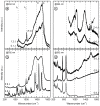How do Nucleotides Adsorb Onto Clays?
- PMID: 30486384
- PMCID: PMC6316844
- DOI: 10.3390/life8040059
How do Nucleotides Adsorb Onto Clays?
Abstract
Adsorption of prebiotic building blocks is proposed to have played a role in the emergence of life on Earth. The experimental and theoretical study of this phenomenon should be guided by our knowledge of the geochemistry of the habitable early Earth environments, which could have spanned a large range of settings. Adsorption being an interfacial phenomenon, experiments can be built around the minerals that probably exhibited the largest specific surface areas and were the most abundant, i.e., phyllosilicates. Our current work aims at understanding how nucleotides, the building blocks of RNA and DNA, might have interacted with phyllosilicates under various physico-chemical conditions. We carried out and refined batch adsorption studies to explore parameters such as temperature, pH, salinity, etc. We built a comprehensive, generalized model of the adsorption mechanisms of nucleotides onto phyllosilicate particles, mainly governed by phosphate reactivity. More recently, we used surface chemistry and geochemistry techniques, such as vibrational spectroscopy, low pressure gas adsorption, X-ray microscopy, and theoretical simulations, in order to acquire direct data on the adsorption configurations and localization of nucleotides on mineral surfaces. Although some of these techniques proved to be challenging, questioning our ability to easily detect biosignatures, they confirmed and complemented our pre-established model.
Keywords: adsorption; geochemistry; origins of life; phyllosilicates; surface chemistry.
Conflict of interest statement
The authors declare no conflict of interest. The funders had no role in the design of the study; in the collection, analyses, or interpretation of data; in the writing of the manuscript; or in the decision to publish the results.
Figures











Similar articles
-
Effects of salinity on the adsorption of nucleotides onto phyllosilicates.Phys Chem Chem Phys. 2018 Jan 17;20(3):1938-1952. doi: 10.1039/c7cp07004g. Phys Chem Chem Phys. 2018. PMID: 29297910
-
Nano-atomic scale hydrophobic/philic confinement of peptides on mineral surfaces by cross-correlated SPM and quantum mechanical DFT analysis.J Microsc. 2020 Dec;280(3):204-221. doi: 10.1111/jmi.12923. Epub 2020 Jun 8. J Microsc. 2020. PMID: 32458447
-
Study of Ferrocyanide Adsorption onto Different Minerals as Prebiotic Chemistry Assays.Astrobiology. 2021 Sep;21(9):1121-1136. doi: 10.1089/ast.2020.2322. Astrobiology. 2021. PMID: 34534004
-
Role of Mineral Surfaces in Prebiotic Chemical Evolution. In Silico Quantum Mechanical Studies.Life (Basel). 2019 Jan 17;9(1):10. doi: 10.3390/life9010010. Life (Basel). 2019. PMID: 30658501 Free PMC article. Review.
-
Anisotropic surface chemistry properties and adsorption behavior of silicate mineral crystals.Adv Colloid Interface Sci. 2018 Jun;256:340-351. doi: 10.1016/j.cis.2018.02.004. Epub 2018 Mar 7. Adv Colloid Interface Sci. 2018. PMID: 29530273 Review.
Cited by
-
Preliminary evidences of the presence of extracellular DNA single stranded forms in soil.PLoS One. 2020 Jan 7;15(1):e0227296. doi: 10.1371/journal.pone.0227296. eCollection 2020. PLoS One. 2020. PMID: 31910237 Free PMC article.
-
Molecular Fingerprints of Hydrophobicity at Aqueous Interfaces from Theory and Vibrational Spectroscopies.J Phys Chem Lett. 2021 Apr 22;12(15):3827-3836. doi: 10.1021/acs.jpclett.1c00257. Epub 2021 Apr 14. J Phys Chem Lett. 2021. PMID: 33852317 Free PMC article.
-
Effect of montmorillonite K10 clay on RNA structure and function.Biophys J. 2024 Feb 20;123(4):451-463. doi: 10.1016/j.bpj.2023.11.002. Epub 2023 Nov 3. Biophys J. 2024. PMID: 37924206 Free PMC article.
-
Clays as Vehicles for Drug Photostability.Pharmaceutics. 2022 Apr 5;14(4):796. doi: 10.3390/pharmaceutics14040796. Pharmaceutics. 2022. PMID: 35456630 Free PMC article. Review.
-
A Physicochemical Consideration of Prebiotic Microenvironments for Self-Assembly and Prebiotic Chemistry.Life (Basel). 2022 Oct 13;12(10):1595. doi: 10.3390/life12101595. Life (Basel). 2022. PMID: 36295030 Free PMC article. Review.
References
-
- Hazen R.M., Sverjensky D.A., Azzolini D., Bish D.L., Elmore S.C., Hinnov L., Milliken R.E. Clay mineral evolution. Am. Mineral. 2013;98:2007–2029. doi: 10.2138/am.2013.4425. - DOI
-
- Giese R.F., Van Oss C.J., Yariv S., Cross H. Organo-Clay Complexes and Interactions. Marcel Dekker; New York, NY, USA: 2002. Organophilicity and hydrophobicity of organo-clays; pp. 175–192.
-
- Bernal J.D. The Physical Basis of Life. Proc. Phys. Soc. Sect. B. 1949;62:598–618. doi: 10.1088/0370-1301/62/11/507. - DOI
Grants and funding
LinkOut - more resources
Full Text Sources

